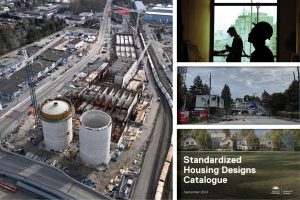This is the second in a series of Industry Perspectives Op-Ed columns where Ken Baerg of Canada Works shares his views on British Columbia’s Community Benefits Agreement (CBA) framework. This article explores the concept of “distraction by acronym.” Read Part One of this series here.
“Distraction by acronym” could be the name of the strategy employed by the B.C. NDP in rolling out their so-called CBA (Community Benefits Agreement) program.
When B.C. Premier John Horgan introduced the CBA framework in July 2018, with Minister of Transportation and Infrastructure Claire Trevena by his side, there was nary a mention of the truly appropriate acronym to frame this model – PLA (Project Labour Agreement) – in its unveiling. Their initial press conference announcing the program failed to note that the pursuit of engaging First Nations, employing apprentices and engaging more women in the construction sector was going to be pursued through an exclusive deal – a PLA – with their political allies and historical big-dollar donors in the Building Trades Unions (BTU), who represent a mere 15 per cent of the construction workforce in B.C.
The Pattullo Bridge, the Broadway Subway Project and improvements to Highway 1 between Kamloops and the Alberta border, collectively worth billions, was to be gifted to the BTU. The NDP knew that all the feel-good initiatives would, at least for a time, serve as a distracting element to this highly egregious move.
Without a doubt, creating opportunities for under-represented groups is a noble pursuit. There is, however, no lucid rationale to justify excluding the vast majority of British Columbian construction workers and sole sourcing a politically aligned labour provider to do billions of dollars worth of work. The parallels between the federal Liberal government’s sole sourcing of public services to political insiders in the charitable sector are not lost.
Notwithstanding increasing public skepticism, more than two years later, the NDP and BTU continue to double down on this exclusive model. And rationalization takes many forms. The following are myths that emerge repeatedly, themes that must be challenged for their inherent flaws.
Note: the acronym PLA – not CBA – will be used to underscore what is truly in play.
Myth #1: PLAs with traditional trades unions have been used to build every dam in B.C., with the exception of Site C, since the 1960s. The model has proven its worth by providing labour peace on major projects.
It is in fact true the WAC Bennett was instrumental in allowing the Allied Hydro Council of BC (an umbrella organization for affiliated unions) to build most of B.C.’s major dams historically, under an exclusive BTU-only model. When these agreements were instituted, the BTU represented a strong majority of qualified workers.
Of course, the principal difference between then and now is the fact that the trade unions no longer possess a strangle hold on the supply of labour and therefore can no longer use the threat of strike or the withholding of skilled tradespeople as a means to hold project owners hostage.
Private sector unionization has plummeted in recent decades and along with it the ability of traditional union leaders to exert their will. While the likes of WAC Bennett needed the traditional unions to play ball in order to get a project completed, those days are long gone.
Site C provides a powerful case in point. It is run as a managed open site, with BC Hydro accepting bids from open shop companies or companies with a progressive union or a traditional union model. Taxpayers benefit from competitive bids and all workers, regardless of union affiliation or lack thereof, are welcome. Open and transparent tendering always trumps monopolies and inclusion is always better than exclusion – two fundamental features conspicuously absent from the NDP’s PLA.
Myth #2: A partnership with the traditional craft unions is the only way to ensure that First Nations, women and apprentices get a chance to work on these projects.
The old-school labour groups do not provide any magical elixir for increasing women in trades, hiring more apprentices and engaging First Nations. In fact, it has been argued many times that their system of dispatch by seniority works to foil such initiatives.
The construction industry as a whole needs to tackle these challenges. As an example, over the years, the percentage of women in the trades has barely moved, having hovered close to five per cent for nearly two decades. This is not a function of employment-ready women being left on the sidelines. Rather, it has to do with cultural and systemic issues in the construction industry that fail to draw women to this sector in the first place. Maybe the old-school unions have something to offer in this space. But they are far from being the answer.
Myth #3: In the 1990s the Island Highway – a taxpayer funded project – was built using a PLA. That project came in on budget.
According to accounting firm BDO Dunwoody, the Island Highway costs were 37 per cent higher than if the work would have been performed under an alternate model. There are inherent inefficiencies when craft unions jealously guard their scope of work and when employees refuse to function as a team. In spite of this, there were still claims of the project coming in on budget – a highly inaccurate assertion when significant overpasses were simply cancelled mid-project without adjusting the budget downwards.
We now live in an era where we simply cannot afford limited competition and exclusionary practises. All contractors and all employees deserve an opportunity to mobilize and to go to work in our province. It doesn’t require astute myth-busting skills to realize that plans rooted in the flawed values of exclusion and political payback are inherently compromised.
Ken Baerg is the executive director of Canada Works, the Council of Progressive Canadian Unions.
Send comments and Industry Perspectives op-ed ideas to editor@journalofcommerce.com.











It is glaringly evident that Horgan is just a Trudeau clone. Voting for Provincial or Federal NDP is voting for Trudeau Liberal.